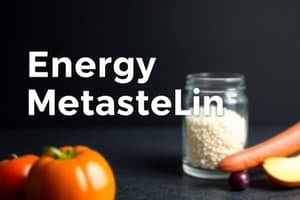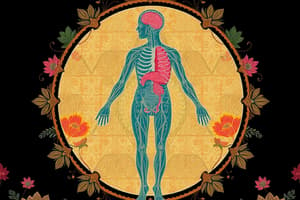Podcast
Questions and Answers
What physiological response triggers hunger?
What physiological response triggers hunger?
- Stretch receptors in the stomach
- Chemical messengers originating in the hypothalamus (correct)
- Increased levels of insulin
- Decreased levels of cholecystokinin
Which component of energy expenditure does NOT involve voluntary movement?
Which component of energy expenditure does NOT involve voluntary movement?
- Thermic effect of food
- Adaptive thermogenesis
- Basal metabolism (correct)
- Physical activity
What must be consumed to sustain a feeling of satiation?
What must be consumed to sustain a feeling of satiation?
- Protein (correct)
- Carbohydrates
- Sugars
- Fats
What is the role of the hypothalamus in the energy balance process?
What is the role of the hypothalamus in the energy balance process?
What mechanism describes the increase in energy expenditure due to food consumption?
What mechanism describes the increase in energy expenditure due to food consumption?
Which type of fat is associated with a higher risk of health complications?
Which type of fat is associated with a higher risk of health complications?
What is the effect of satiation in the context of eating behavior?
What is the effect of satiation in the context of eating behavior?
What is not a component of energy expenditure?
What is not a component of energy expenditure?
What is the primary function of the electron transport chain in cellular respiration?
What is the primary function of the electron transport chain in cellular respiration?
Why do fats provide more energy per gram compared to carbohydrates?
Why do fats provide more energy per gram compared to carbohydrates?
What happens to excess carbohydrates consumed during feasting?
What happens to excess carbohydrates consumed during feasting?
How does the body adapt to fasting conditions?
How does the body adapt to fasting conditions?
What process does the body use to convert amino acids into glucose during fasting?
What process does the body use to convert amino acids into glucose during fasting?
What is a key feature of ketosis as an alternative energy source?
What is a key feature of ketosis as an alternative energy source?
What defines intermittent fasting?
What defines intermittent fasting?
Which of the following best describes low-carbohydrate diets in relation to metabolism?
Which of the following best describes low-carbohydrate diets in relation to metabolism?
What is the primary role of glucose in cellular metabolism?
What is the primary role of glucose in cellular metabolism?
What occurs to pyruvate in aerobic conditions?
What occurs to pyruvate in aerobic conditions?
Which statement about fatty acids in energy metabolism is true?
Which statement about fatty acids in energy metabolism is true?
What happens to amino acids during deamination?
What happens to amino acids during deamination?
Which pathway does the TCA cycle represent in energy metabolism?
Which pathway does the TCA cycle represent in energy metabolism?
When ATP levels are high, what does acetyl CoA primarily produce?
When ATP levels are high, what does acetyl CoA primarily produce?
Which of the following correctly describes glycolysis?
Which of the following correctly describes glycolysis?
What is the primary fate of lactate formed from pyruvate?
What is the primary fate of lactate formed from pyruvate?
Which factor does NOT influence Basal Metabolic Rate (BMR)?
Which factor does NOT influence Basal Metabolic Rate (BMR)?
What is a major health risk associated with high body fat distribution, specifically central obesity?
What is a major health risk associated with high body fat distribution, specifically central obesity?
Which measure is widely recognized as a good indicator of central obesity?
Which measure is widely recognized as a good indicator of central obesity?
What does the set-point theory suggest about body weight regulation?
What does the set-point theory suggest about body weight regulation?
Which of the following is NOT considered a treatment option for obesity?
Which of the following is NOT considered a treatment option for obesity?
Which characteristic is most closely associated with anorexia nervosa?
Which characteristic is most closely associated with anorexia nervosa?
What hormone is primarily associated with the regulation of appetite and body weight?
What hormone is primarily associated with the regulation of appetite and body weight?
What is the main metabolic consequence of lipoprotein lipase (LPL) activity in fat cells?
What is the main metabolic consequence of lipoprotein lipase (LPL) activity in fat cells?
Flashcards
Glycolysis
Glycolysis
The process of breaking down glucose into pyruvate.
Pyruvate
Pyruvate
A 3-carbon compound produced from glucose breakdown during glycolysis.
Aerobic vs. Anaerobic Pyruvate Pathways
Aerobic vs. Anaerobic Pyruvate Pathways
Pyruvate can either be converted to lactate (anaerobic) or acetyl CoA (aerobic), depending on oxygen availability.
Acetyl CoA
Acetyl CoA
Signup and view all the flashcards
TCA Cycle
TCA Cycle
Signup and view all the flashcards
Fatty Acid Oxidation
Fatty Acid Oxidation
Signup and view all the flashcards
Gluconeogenesis
Gluconeogenesis
Signup and view all the flashcards
Amino Acid Deamination
Amino Acid Deamination
Signup and view all the flashcards
Electron Transport Chain
Electron Transport Chain
Signup and view all the flashcards
Energy From Fat
Energy From Fat
Signup and view all the flashcards
Feasting: Excess Energy Storage
Feasting: Excess Energy Storage
Signup and view all the flashcards
Fasting: Glucose Production
Fasting: Glucose Production
Signup and view all the flashcards
Fasting: Ketone Bodies
Fasting: Ketone Bodies
Signup and view all the flashcards
Intermittent Fasting
Intermittent Fasting
Signup and view all the flashcards
Low-Carb Diets & Ketosis
Low-Carb Diets & Ketosis
Signup and view all the flashcards
Adaptation to Fasting
Adaptation to Fasting
Signup and view all the flashcards
Energy balance
Energy balance
Signup and view all the flashcards
Energy in
Energy in
Signup and view all the flashcards
Energy out
Energy out
Signup and view all the flashcards
Basal Metabolic Rate (BMR)
Basal Metabolic Rate (BMR)
Signup and view all the flashcards
Thermic Effect of Food (TEF)
Thermic Effect of Food (TEF)
Signup and view all the flashcards
Satiation
Satiation
Signup and view all the flashcards
Satiety
Satiety
Signup and view all the flashcards
Hypothalamus
Hypothalamus
Signup and view all the flashcards
Healthy Body Weight
Healthy Body Weight
Signup and view all the flashcards
Body Mass Index (BMI)
Body Mass Index (BMI)
Signup and view all the flashcards
Waist Circumference
Waist Circumference
Signup and view all the flashcards
Set-Point Theory
Set-Point Theory
Signup and view all the flashcards
Leptin
Leptin
Signup and view all the flashcards
Ghrelin
Ghrelin
Signup and view all the flashcards
Obesogenic Environment
Obesogenic Environment
Signup and view all the flashcards
Weight Cycling (Yo-Yo Dieting)
Weight Cycling (Yo-Yo Dieting)
Signup and view all the flashcards
Study Notes
Exam 3 Study Guide - Human Nutrition
- Exam Format: 55 questions (37 multiple choice @ 2pts/q; 10 matching @ 1pt/q; 6 T/F @ 1pt/q; 2 short answer @ 5pts/q)
Chapter 7: Energy Metabolism
-
Key Terms: Acetyl CoA, Anabolism, ATP, Cori cycle, Catabolism, Coenzymes, Glycolysis, Metabolism, Electron transport chain, Gluconeogenesis, Pyruvate TCA cycle
-
Glucose Metabolism (Central Role):
- Glucose is broken down into 3-carbon compounds (pyruvate) via glycolysis.
- Pyruvate can follow anaerobic (lactate) or aerobic (acetyl CoA) pathways.
- Aerobic pathway is more sustainable, while anaerobic provides quick energy.
- Acetyl CoA enters the TCA cycle.
-
Fat Metabolism (Glycerol & Fatty Acids):
- Triglycerides are broken down into glycerol and fatty acids.
- Glycerol can be converted to pyruvate.
- Fatty acids are broken down into two-carbon fragments (acetyl CoA) processed by the electron transport chain with coenzymes.
- Fatty acids cannot be converted into glucose.
-
Amino Acid Metabolism:
- Amino acids are deaminated, losing nitrogen-containing groups.
- Some amino acids convert to pyruvate or acetyl CoA.
- Others enter the TCA cycle directly.
-
Final Steps of Energy Metabolism:
- Acetyl CoA synthesizes fats or generates ATP (high-energy compound) via the TCA cycle and electron transport chain.
- Electron transport chain uses proteins as electron carriers to create ATP.
- Carbohydrates and fats yield different energy per gram (fats most, then protein, then carbohydrates).
Chapter 8: Energy Balance and Body Composition
-
Energy in:
- Food composition: Energy values determined by bomb calorimetry.
- Food intake: Body regulates hunger and satiation through nerve signals & hormones (hypothalamus).
- Overriding hunger: Appetite.
- Satiation for proper energy intake.
-
Energy Out:
- Components: Basal metabolism, physical activity, thermic effect of food, adaptive thermogenesis.
- Basal metabolism: Essential activities at rest.
- Physical activity: Voluntary movement.
- Thermic effect of food: Energy expenditure after eating.
- Adaptive thermogenesis: Adjustments to energy expenditure.
-
Body Weight & Composition:
- Defining healthy body weight: Relative weight for height (BMI).
- Body fat distribution (waist circumference).
- Related risks from excess body weight and fat.
Chapter 9: Weight Management
- Causes of Overweight/Obesity Genetics, epigenetics, overeating, Physical inactivity
- Problems due to Overweight and Obesity Health risks, perceptions, dangerous interventions
- Aggressive Treatments for Obesity Drugs, surgery, and other medical procedures. Fad dieting.
Chapters 10 & 11: Vitamins
- Key terms related to anemia, blindness, deficiencies, and toxicities of vitamins (A, D, E, K, B complex, folate, etc..).
- Vitamin sources and their functions.
Chapter 12: Water
- Water Balance: Hypothalamus, osmosis, electrolytes, ADH, renin, and water balance regulation.
- Water Intake: Water sources and recommendations.
- Health Effects: Negative consequences or risks related to water intake or deficiencies.
Studying That Suits You
Use AI to generate personalized quizzes and flashcards to suit your learning preferences.




